Below are some quick tells from the front for the late model Studebaker Sedans and Wagons.
|
New hood ornament and Coat of Arms badge. The near square mesh grille does not wrap around like 57 & 58 would. The Hawk like side surrounds are seen on both sides and the signal/running lights are on the outer edges just above the bumpers. |
Same Hood Ornament, but the Coat of Arms Badge has grown wings. The mesh grille has a more rectangular pattern and wraps around the side of the fenders and a new bumpers is used. Signal/running lights are now below the bumper. |
The Coat of Arms badge and hood ornament are gone replaced with
Studebaker script on the bottom of the hood. The only year duel headlight are seen. The grille bars are thicker and the grille has fewer rectangles. | The common theme for 1956 to 1958 sedans and wagons is the squared off look and mesh grilles.
After
the 1953 to 1955 design cycle, in 1956, Studebaker was ready to
reshape the sedan and wagon body panels front and back. While the
center section would remain the same, gone were the sloping hood and
trunk. The new face lift would introduce squared-up styling for
1956. Many of the Studebaker executives felt that Studebaker had
developed a reputation for creating odd looking cars and wanted to
break that cycle for 1956. Lowey's expensive contract was not
renewed for the sedan and wagon design. Most of the exterior design
work is done by Vince Gardner (now a freelance designer) and most of
the interior is done by Duncan McRae.
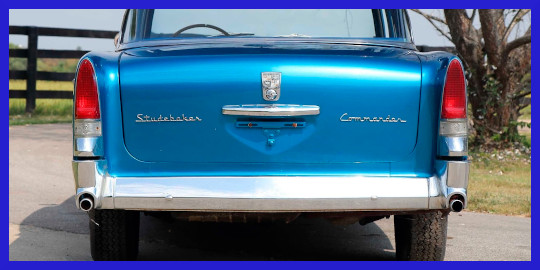 The
grille, fenders, taillights and sedan rear bumper are new. The sedan
rear bumper, has slots for the exhaust pipes, which was all the rage
in the mid-fifties. However, after the chrome pitted and turned
black, not so much. The side “reverse angle contour” (still
present on Hawks), seen since 1953 is The
grille, fenders, taillights and sedan rear bumper are new. The sedan
rear bumper, has slots for the exhaust pipes, which was all the rage
in the mid-fifties. However, after the chrome pitted and turned
black, not so much. The side “reverse angle contour” (still
present on Hawks), seen since 1953 is 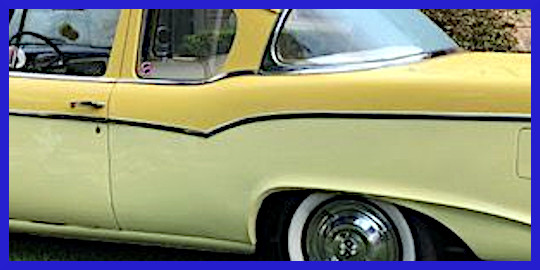 eliminated. The rear quarter
panel on the new two-door sedans extends all the way to the door,
finally removing that fake looking rear ½ door look. eliminated. The rear quarter
panel on the new two-door sedans extends all the way to the door,
finally removing that fake looking rear ½ door look. 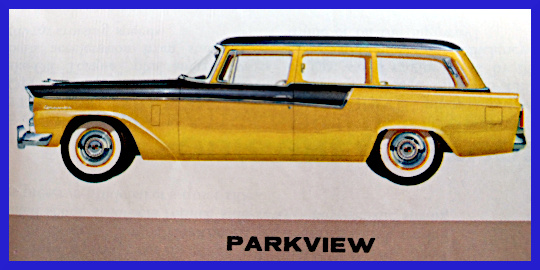 The wagon,
still has the sloping rear quarter panel, but a small fin is added to
remove the slope. The wagon,
still has the sloping rear quarter panel, but a small fin is added to
remove the slope. 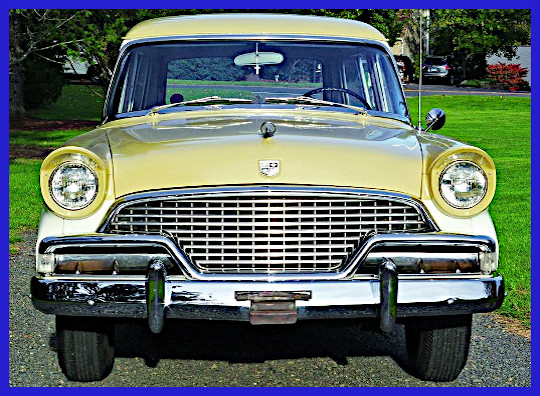 The new grille has a large center section of
square mesh, with two side grilles. The coat of arms badge returns to
the center of the hood and there is a new bull's eye hood ornament. The 1947 to 1949 regular hubcaps return, the full The new grille has a large center section of
square mesh, with two side grilles. The coat of arms badge returns to
the center of the hood and there is a new bull's eye hood ornament. The 1947 to 1949 regular hubcaps return, the full 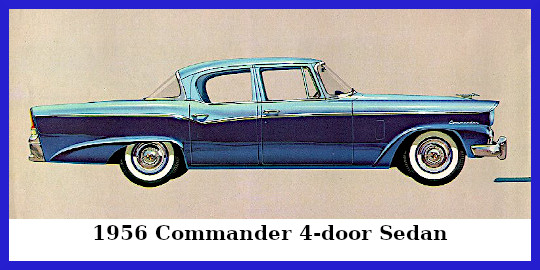 wheel covers are
new. Eyebrows top the headlights and a single side trim starts near
the headlight and ends at the taillight. It droops starting at the
front of the front door, running just below the door handles and then
kicks up rapidly and finishes in a straight wheel covers are
new. Eyebrows top the headlights and a single side trim starts near
the headlight and ends at the taillight. It droops starting at the
front of the front door, running just below the door handles and then
kicks up rapidly and finishes in a straight 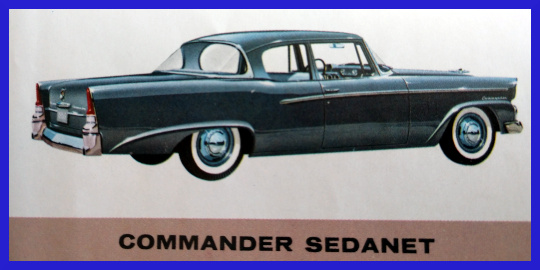 line to the end.
Exception on this trim is the Sedanet, where the side trim ends just
before the rear wheel well. Both the front fenders and the
rear-quarter panels have stamped-in flares just behind the wheel
wells. line to the end.
Exception on this trim is the Sedanet, where the side trim ends just
before the rear wheel well. Both the front fenders and the
rear-quarter panels have stamped-in flares just behind the wheel
wells.
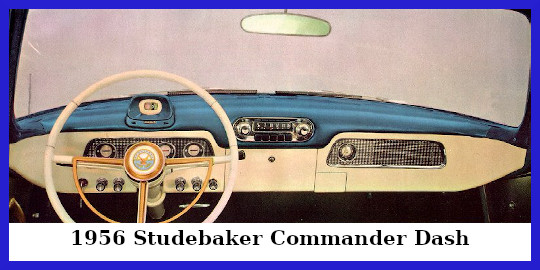 The
interior has a new dash design featuring a “Cyclops Eye”
speedometer on top of the four remaining instruments below; two
“idiot lights” for amps and oil pressure; and two red and green
lighted gauges for gas and temperature. The light and heater
controls were placed below these four gauges. The glove box is in
the center of the dash, below the radio (if installed else below the
radio delete panel). The clock and The
interior has a new dash design featuring a “Cyclops Eye”
speedometer on top of the four remaining instruments below; two
“idiot lights” for amps and oil pressure; and two red and green
lighted gauges for gas and temperature. The light and heater
controls were placed below these four gauges. The glove box is in
the center of the dash, below the radio (if installed else below the
radio delete panel). The clock and 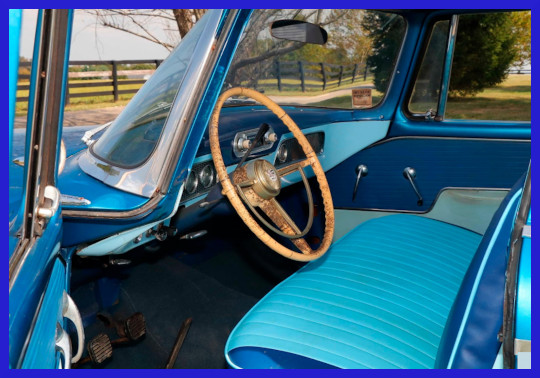 radio speaker (if installed) are
to the far right. Built in arm rests and colorful new cloth/vinyl or
all-vinyl upholstery are available. The door handles and window
cranks are now installed with hidden snap rings instead of those
former visible Phillips screws. radio speaker (if installed) are
to the far right. Built in arm rests and colorful new cloth/vinyl or
all-vinyl upholstery are available. The door handles and window
cranks are now installed with hidden snap rings instead of those
former visible Phillips screws.
Mechanical
changes were limited, but significant. First, the electrical
system is now 12 volts. This would be the year most American car
manufactures changed over from 6 volts to 12 volts. 12 volt system
provided more starting power and could support a heavier electrical
load for things like power windows, power seats, and air
conditioning. Second, gone forever is the Automatic Drive
transmission. Having never lived up the volume Borg Warner or for
that matter Studebaker it's self had expected, this transmission just
becomes to expensive. The replacement is the Flightomatic, a two
speed automatic similar to a transmission Borg Warner would make for
Ford called the Fordomatic. Studebaker would use the PNDLR shift
pattern where Ford used PRNDL. The Flightomatic has no torque
converter bypass, but is a lot cheaper to produce. This would be the
staple automatic for Studebaker until the end of production.
Restoration
Information: Commanders and
Champion ride on the same wheel base, 116.5 inches and the sheet
metal was the same for both cars. The difference, mainly in the
engine where Commanders were V8's and Champion's were straight-six. The model line-up was identical. One Wagon (Parkview / Pelham), one 4-door Sedan, one 2-door Sedan,
and one 2-door Sedanet. The former trim levels like “Custom”,
“DeLuxe”, “Regal” are eliminated. The Sedanet is the least
expensive car, but is not near as spartan as the former “Custom”
series. They were initially painted only in single tone colors. Studebaker like most manufactures though the public was not
interested in a stripped down very spartan car. The Scotsman's for
1957 would prove how much they were wrong. At start of production 23
two-tone paint combinations were available and 10 solid colors. In
the spring, 6 new two-tone combinations would be offered and the Sedanet could be had with most of the color combinations. Five metallic
colors were used and two of the two-tone color combinations were
available only on President Classic, (Mocha/Doeskin and Mocha/Snowcap
White). While of coarse , many options and accessories were
available, the newest would be the uniquely mounted “Karbelt”
(seat belt), which was attached to the door, not the floor. When not
in use, the longer section clipped to the door for storage. It was
though that this set-up would prevent the door from flying open in
the event of an accident.
|
Specification 1956 Studebaker Commander |
|
259 Sweepstakes OHV V8 |
|
Bore (inches) |
3 9/16 |
|
Stroke (inches) |
3 1/4 |
|
Displacement (cu.
in.) |
259.2 |
|
Horsepower |
170 @ 4500 rpm /1185 with 4bbl & duel exhaust |
|
Torque (lb-ft) |
260 @ 2,800 |
|
Compression ratio |
7.8:1 optional
8.0:1 |
|
Carburetor |
Stromberg model WW
two-barrel |
|
1Carburetor
(opt. 4bbl) |
Carter WCFB
four-barrel |
|
Electrical
Equipment |
Delco-Remy |
|
Spark Plugs |
Champion H-11 |
|
Battery |
Willard HWD |
|
Tire Size |
6.70 x 15 |
|
Wheel Base
Commander F,W&D |
116.5 inches |
|
1The
additional HP listed above could only be achieved if the duel
exhaust accessory was installed with the 4bbl WCFB Carter
carburetor. The entire engine except the valve covers was painted
Turquoise. The valve covers, oil filler cap, and air cleaner were
painted black. Electrical components were black, except the
overdrive relay. The carburetor, fuel pump, coil clamp, voltage
regulator base, overdrive relay, air cleaner wingnut, battery
clamp wingnuts and washers, hose clamps, and radiator cap were
natural metal color. The oil filter canister, if factory
installed was engine color, add-on Fram oil filters were Fram
orange with black lids. The fan would be engine color, but some
fans were black. The battery box was body color, but the top
clamp was black. The radiator, radiator support frame, and upper
radiator air deflector were black. The hood latch base in the air
deflector was natural metal. Engine color over spray was common
on the starter and fuel pump (if factory installed). There were
decals on the air cleaner, oil filler tube cap and oil filter
canister. The valve covers have engine decals “Sweepstakes
259”. The bell housing and transmission were engine color, the
rest of the drive train and chassis was painted black. |
|
Capacities |
|
Gas Tank (gals) |
18 |
|
Cooling System
(qts) |
17 1/4 ( with
climatizer add 1 1/2) |
|
Engine (qts) |
6 (w/oil filter
add one more) |
|
Rear Axle Ratio |
4.09:1 |
|
With Overdrive |
4.55:1 |
|
1956
Commander 2dr & 4dr Sedan Interior Seat Fabric (Domestic
Models) |
|
Standard
Upholstery |
Optional Extra
Cost Upholstery |
|
Triangle
Pattern Cloth with Vinyl Bolster |
Vinyl
Seats with Vinyl Bolsters |
|
Cloth Color |
Vinyl Bolster Color |
Seat Color |
Bolyster Color |
|
Charcoal
Black |
Off White |
Charcoal
Black |
Off White |
|
Dark Blue |
Light Blue |
Light Blue |
Dark Blue |
|
Dark Green |
Light
Green |
Light
Green |
Dark Green |
|
|
|
Dark Taupe |
Light
Taupe |
|
1956
Commander Parkview Wagon Interior Seat Fabric (Domestic Models) |
|
Standard
Upholstery |
Optional No
Extra Cost Upholstery |
|
Charcoal
Black Vinylap with Off White Vinyl Bolster |
Nylon
Frieze Cloth and Off White Vinyl Bolster |
|
1956
Sedan & Wagon Exterior (Solid Colors) |
|
Midnight
Black |
|
5611 |
|
Snowcap
White |
|
5612 |
|
Daybreak
Blue |
|
5613 |
|
Airforce
Blue Metallic |
|
5614 |
|
Seaside
Green |
|
5615 |
|
Glenbrook
Green Metallic |
|
5616 |
|
Cambridge
Grey Metallic |
|
5617 |
|
Yellowstone |
|
5618 |
|
1956
Sedan & Wagon Exterior (Two-Tone Colors) |
|
Accent
Color |
Basic
Color |
Code |
|
Daybreak
Blue |
Airforce
Blue Metallic |
5620 |
|
Airforce
Blue Metallic |
Daybreak
Blue |
5621 |
|
Snowcap
White |
Daybreak
Blue |
5622 |
|
Snowcap
White |
Airforce
Blue Metallic |
5623 |
|
Seaside
Green |
Glenbrook
Green Metallic |
5624 |
|
Glenbrook
Green Metallic |
Seaside
Green |
5625 |
|
Snowcap
White |
Seaside
Green |
5626 |
|
Snowcap
White |
Glenbrook
Green Metallic |
5627 |
|
Snowcap
White |
Cambridge
Grey Metallic |
5628 |
|
Snowcap
White |
Midnight
Black |
5629 |
|
Midnight
Black |
Snowcap
White |
5630 |
|
Midnight
Black |
Romany
Red |
5631 |
|
Romany
Red |
Midnight
Black |
5632 |
|
Romany
Red |
Snowcap
White |
5633 |
|
Snowcap
White |
Romany
Red |
5634 |
|
Sunglow
Gold |
Snowcap
White |
5635 |
|
Snowcap
White |
Sunglow
Gold |
5636 |
|
Doeskin |
Mocha |
56371 |
|
Snowcap
White |
Mocha |
56381 |
|
Midnight
Black |
Yellowstone |
5639 |
|
Sunglow
Gold |
Yellowstone |
5640 |
|
Snowcap
White |
Tangerine |
56422 |
|
Snowcap
White |
Rosebud |
56643 |
|
Snowcap
White |
Redwood
Metallic |
56653 |
|
Redwood
Metallic |
Snowcap
White |
56663 |
|
Seaside
Green |
Midnight
Black |
56673 |
|
Daybreak
Blue |
Cambridge
Grey Metallic |
56683 |
|
Snowcap
White |
Yellowstone |
56693 |
|
1Only
available on the President Classic. 2Discontinued in
April 1956. 3Spring color combinations introduced in
April 1956. |
|
1956
Studebaker Commander Series 56B |
|
Model
Description |
No.
Doors |
Passengers |
CCD
Price |
TW
Price |
No.
Produced |
|
Sedanet
(F2) |
2 |
6 |
$1792.00 |
$1,974.00 |
1,523 |
|
Sedan
(F4) |
2 |
6 |
$1886.00 |
$2,076.00 |
3,663 |
|
Sedan
(W2)1 |
4 |
6 |
? |
? |
335 |
|
Sedan
(W4) |
4 |
6 |
$1931.00 |
$2,125.00 |
14,700 |
|
Parkview
Wagon (D4)2 |
2 |
6 |
$2144.00 |
$2,354.00 |
3,333 |
|
Total |
23,544 |
|
1Custom
Special Order (police cars, taxicabs and models only sold outside
the U.S.) 2Numbers include D8 Ambulet production 3Technically of coarse the Hawks are not be in the
Sedan and Wagon series, but are included here as the Power Hawks
were considered to be Commanders. |
|
Serial
Numbers |
|
Location |
Start |
End |
|
South
Bend |
8,429,601 |
8,454,100 |
|
Los
Angeles |
8,849,101 |
8,852,868 |
|
Canada |
8,960,001 |
8,962,600 |
|
Numbers
are sourced from TW October 1989 – Fred Fox featured article. |
|
Engine
Numbers |
|
Location |
Start |
End |
|
South
Bend |
V-363,751 |
V-390,000 |
|
Los
Angeles |
VL-6,301 |
VL-10,068 |
|
Canada |
VC-8,101 |
VC-10,700 |
Numbers
are sourced from TW October 1989 – Fred Fox featured article. |
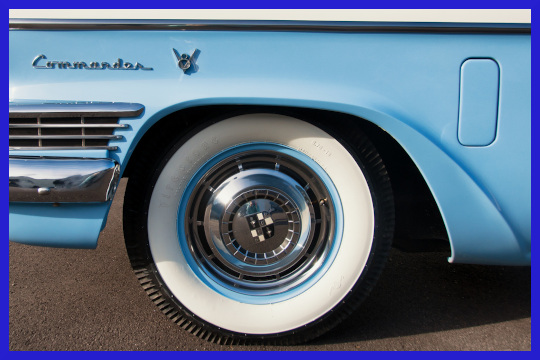 The 1957
Sedans and Wagons were mostly based on the 1956 models, the 1957
exterior changes included new front and rear bumpers, a new grille
design, and new taillights. The side trim and the full rim hubcaps
were revised. New this year is the Provincial 4-door Station Wagon. On the interior, the speedometer housing is widened to include turn
signal indicators. The molded-in arm rests from 56 are replaced with
a conventional replaceable versions and a new dished steering wheel
is standard on all but a few of the earlier Custom models.
 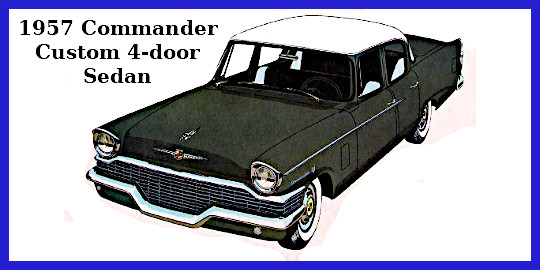 The model line-up strategy seems to have changed. Commanders and Champions Sedans are grouped together (use the same sheet metal, trim, and interior) with only the engine and front fender badges different. Commanders of would use the 259 V8, while the Champion used the 185 Six. Other then 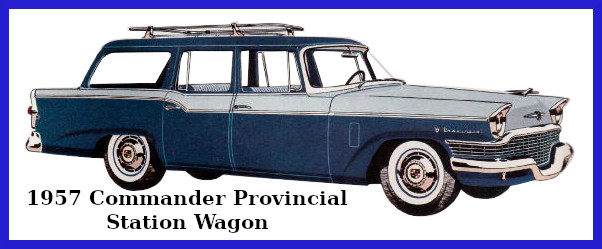 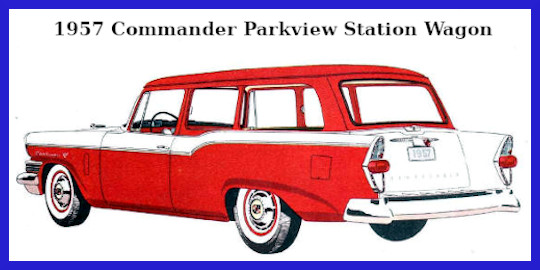 the engine only the front fender badge would identify these two models. Both would be offered in Custom and Deluxe trim levels. In 1957 Studebaker wanted to separate the Wagons from the Sedans by just using their respective names, however if you consider engine size (259 V8) only the two door Parkview and the four door Provincial wagons fit in the Commander series.
Mechanical improvements include increased power for the 259 V8, new
variable ratio front coil springs and optional Twin-Traction
introduced on 1956 Packard's and light duty Studebaker trucks. There
is no Los Angeles production as LA is shutdown at the end of the 1956
model-year.
Restoration
Information:
|
Specification 1957
Studebaker Commander |
|
259 Sweepstakes OHV V8 |
|
Bore (inches) |
3 9/16 |
|
Stroke (inches) |
3 1/4 |
|
Displacement (cu.
in.) |
259.2 |
|
Horsepower |
180 @ 4500 rpm /1195 with 4bbl & duel exhaust |
|
Torque (lb-ft) |
260 @ 3,000 |
|
Compression ratio |
8.3:1 |
|
Carburetor |
Stromberg model WW
two-barrel |
|
1Carburetor
(opt. 4bbl) |
Carter WCFB
four-barrel |
|
Electrical
Equipment |
Delco-Remy |
|
Spark Plugs |
Champion H-11 |
|
Battery |
Willard |
|
Tire Size |
6.70 x 15 |
|
Wheel Base
Commander F,W&D |
116.5 inches |
|
1The
additional HP listed above could only be achieved if the duel
exhaust accessory was installed with the 4bbl WCFB Carter
carburetor. The entire engine except the valve covers was
initially painted Turquoise, however later in the year (most
likely May 1957) the engine color changed to Silver-gray. The
valve covers, oil filler cap, and air cleaner were painted black.
Electrical components were black, except the overdrive relay. The
carburetor, fuel pump, coil clamp, voltage regulator base,
overdrive relay, air cleaner wingnut, battery clamp wingnuts and
washers, hose clamps, and radiator cap were natural metal color.
The oil filter canister, if factory installed was engine color,
add-on Fram oil filters were Fram orange with black lids. The fan
would be engine color, but some fans were black. The battery box
was body color, but the top clamp was black. The radiator,
radiator support frame, and upper radiator air deflector were
black. The hood latch base in the air deflector was natural
metal. Engine color over spray was common on the starter and fuel
pump (if factory installed). There were decals on the air
cleaner, oil filler tube cap and oil filter canister. The valve
covers have engine decals “Sweepstakes 259”. The bell housing
and transmission were engine color, the rest of the drive train
and chassis was painted black. |
|
Capacities |
|
Gas Tank (gals) |
18 |
|
Cooling System
(qts) |
17 1/4 ( with
climatizer add 1 1/2) |
|
Engine (qts) |
6 (w/oil filter
add one more) |
|
Rear Axle Ratio |
4.09:1 |
|
With Overdrive |
4.55:1 |
| Exterior Colors: 1957 Sedans & Wagons Solid Colors |
|
|
| Color |
Code |
Studebaker |
Packard |
| Midnight Black |
P5710 |
x |
x |
|
Artic White
|
P5711 |
x |
x |
| Apache Red
|
P5712 |
x |
|
|
Coppertone Metallic
|
P5713 |
x |
|
|
Tiara Gold Metallic
|
P5714 |
x |
|
| Woodsmoke Grey Metallic |
P5715 |
x |
x |
|
Glendale Green Metallic
|
P5716 |
x |
x |
|
Turquoise
|
P5717 |
x |
x |
| Azure Blue Metallic |
P5718 |
x |
x |
|
Wedgewood Blue
|
P5719 |
x |
x |
| Taupe Metallic |
P5720 |
x |
|
| Regal Red |
P5771 |
|
x |
| Cumberland Grey |
P5772 |
|
x |
| Lilac |
P5773 |
|
x |
|
Slate Mist Metallic
|
P57791 |
x |
x |
| Inca Cream |
P57801 |
x |
x |
| Admiral Blue |
P57862 |
x |
|
| Highland Grey |
P57872 |
x |
|
| Lombard Green |
P57882 |
x |
|
| 1Spring Color. 2Scotsman Only. The Lombard Green color offered on 1957 Scotsmans was a returned 1953 color. The lower instrument panel color on Scotsmans was Florida Beige.
The panel under the front bumper on all Scotsmans and most later
model Sedans and Wagons was painted Silver-grey. |
|
1957 Sedan & Wagon Exterior Two-tone Colors |
|
Accent Color |
Basic Color1 |
Code |
Studebaker |
Packard |
| Turquoise |
|
P5721 |
x |
|
| Glendale Green Metallic |
|
|
|
|
|
Artic White |
|
|
|
x |
|
Artic White |
|
|
x |
x |
|
Midnight Black |
|
|
x |
|
|
|
|
|
x |
x |
|
|
|
|
x |
|
|
|
|
|
x |
x |
|
|
|
|
x |
x |
|
|
Coppertone Metallic |
|
x |
x |
|
Midnight Black |
|
|
x |
|
|
|
|
|
x |
x |
|
|
|
|
x |
|
|
|
Woodsmoke Gray Metallic |
|
x |
x |
|
|
|
|
x |
|
|
|
Tiara Gold Metallic |
|
x |
x |
|
|
Taupe Metallic |
|
x |
x |
|
|
Apache Red |
|
x |
|
|
|
Regal Red |
|
|
x |
|
|
Lilac |
|
|
x |
|
|
|
|
|
x |
|
|
|
|
x |
x |
|
Artic White |
Inca Cream |
|
x |
x |
|
Cumberland Gray |
Slate Mist Metallic |
|
|
x |
|
1The basic color in the lower color.
2Spring colors. |
|
Upholstery Materials: 1957 Commander Sedans & Wagons |
|
A detailed presentation of all the interior fabrics and the exterior colors that they went with is beyond our scope here. That information can be found in Studebaker's 1957 Color and Fabric Selector dealer album. The following is just a listing of the fabrics and trim codes. The trim codes show up on the production orders. Production Orders for most years and models can be purchased from the Studebaker National Museum. Most fabrics are two-tone, light and dark. |
|
Custom Commanders |
|
Triangle Pattern Cloth & Hair Cell Grained Vinyl |
| Color |
Code |
| Charcoal (& off white) |
21 CH |
| Blue (two-tone) |
22 BL |
| Green (two-tone) |
23 GR |
|
Deluxe Commanders |
|
Jacquard Cloth & Down Cushion Vinyl |
| Color |
Code |
| Charcoal (two-tone) |
41 CH |
| Blue (two-tone) |
42 BL |
| Green |
43 GR |
|
Parkview & Provincial Wagons |
|
Pre-embossed Down Cushion Vinyl & Grained Vinyl |
| Color |
Code |
| Charcoal (& white) |
51 CHV |
| Blue (two-tone) |
52 BLV |
| Green (two-tone) |
53 GRV |
| Red (& white) |
54 RDV
|
1957
Studebaker Commander Series 57B, 116.5 in. wheelbase
|
Model |
No. Doors |
Passengers |
CCD Price |
1TW Price |
No. Produced |
|
Custom 4Dr Sedan (W2) |
4 |
6 |
$1,976.00 |
$2,173.00 |
828 |
|
DeLuxe 4Dr Sedan (W4) |
4 |
6 |
$2,089.00 |
$2,295.00 |
10,285 |
|
Custom 2Dr Club Sedan (F2) |
2 |
6 |
$1,931.00 |
$2,124.00 |
530 |
|
DeLuxe 2Dr Club Sedan (F4) |
2 |
6 |
$2,044.00 |
$2,246.00 |
2,072 |
|
Parkview 2Dr Wagon (P4) |
2 |
6 |
$2,284.00 |
$2,505.00 |
738 |
|
Provincial 4Dr Wagon (P4) |
4 |
6 |
$2,336.00 |
$2,561.00 |
3995 |
|
Total |
18,448 |
|
1Delivered
Price |
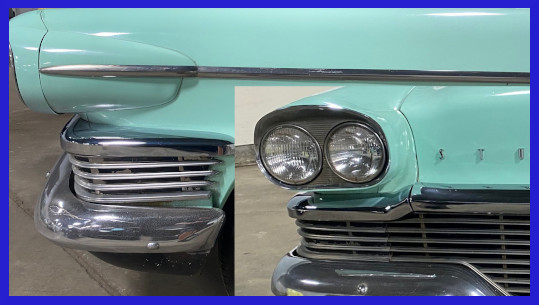 For 1958
Sedans and Wagons, this is the year Studebaker just wants to get by
until the Lark launch in the fall. However, this does not mean that
nothing is happening, the year is actually quite interesting. First,
we will finally get a sedan hardtop, but only in the 2-door form,
Studebaker would never make a 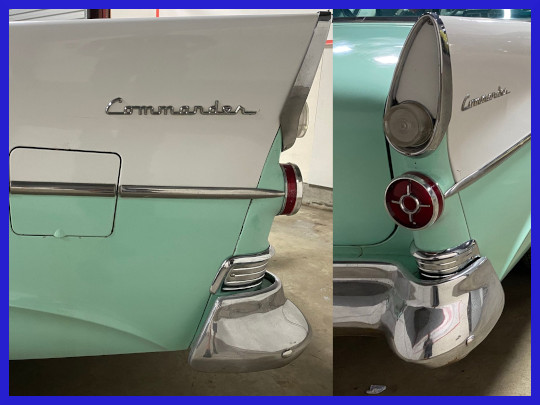 4-door sedan hardtop. Second, would be
much larger tail fins. Like nearly everyone in the automotive
industry, big fins are in. Studebaker sedans and wagons would sport
them as well. Third, duel headlights are a must for 1958, the entire
industry going this route. However Studebaker's treatment (add on
pods) would be cheap and cheesy and would be the biggest controversy
of the year. We probably need to cut Duncan McRae some slack, as for
sure he had few tooling dollars to work with. Most of what was
available was spent on tail-fins and the Hardtop.
Exterior: The roof line would be much more flat and 1 ½ inches lower. Add
that to the 14 inch wheels and you get a much longer and lower
looking Commander and President. Model name badges would go from the
front fender to the rear fin. In the front, the hood ornament and
crest are removed and “Studebaker” is 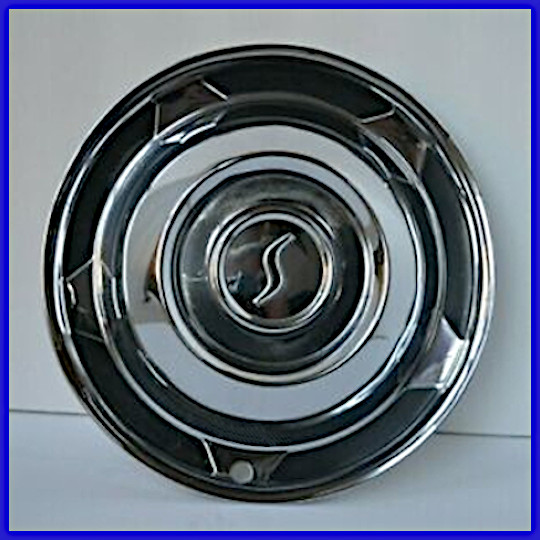 now displayed near the
bottom of the hood. The grille is refined, it looks more substantial
with somewhat thicker bars and a lot fewer rectangular holes. On
Commanders and Presidents a large “V” is added to the center of
the grille. In the rear, large fins end with new round taillights. The deck lid is unchanged from last year. Commanders and Presidents
have new hubcaps due to the use of 14” wheels. If you see a
Studebaker with 1957 hubcaps, it's a Champion or a Commander with
optional 15 inch wheels. The front and rear bumpers and bumper
guards are not touched. All 1958 Studebaker's would have a grille
based vent system (gone in the entire sedan and wagon line are the
front fender vents doors seen since 1941.)
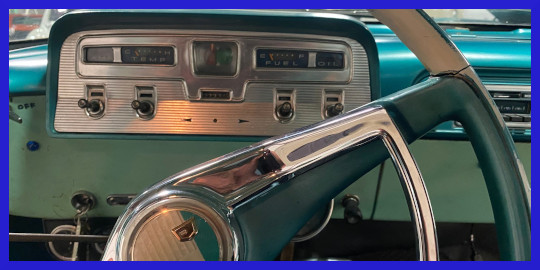 Interior: Interior: A new enlarged the speedometer housing holds real gauges and several
toggle switches. The ignition keyway is lighted, a new dished steering wheel is seen and smaller
flush-level door sill molding are added. Many new fabrics, colors
and prints are available in cloth and vinyl or all vinyl.
Mechanical:
Asymmetric rear springs (longer to the rear) and a new one-piece
drive shaft. Commanders and President ride on 14” wheels and tires,
optional on Champion's.
Provincial 4-door Wagon Commander 4-door Sedan
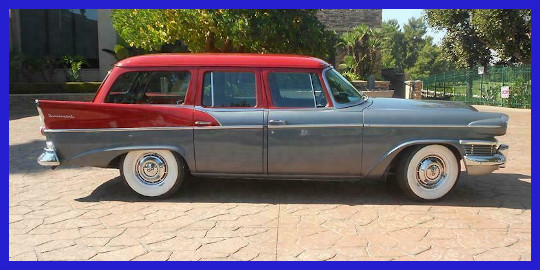 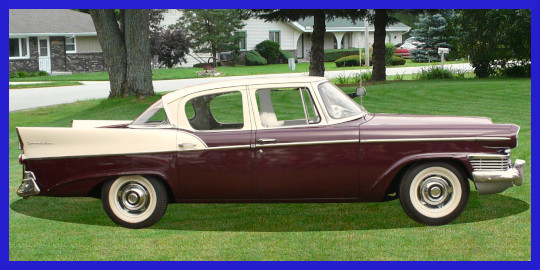 The
Commander line really shrinks, with a single trim line (D4, W4, and
J4), apparently last years Deluxe trim with an added Hardtop Sedan. The two-door Sedan and two-door Wagon are eliminated.
Interesting that in the photos the wagon has, optional 1957 15 inch wheels & hubcaps, the 4-door sedan has the correct 1958 14 inch wheels & hubcaps, and the hardtop looks to have some type of aftermarket small hubcaps with trim rings (they do look like 14 inch wheels, but could be an illusion because of the narrow white walls).
Commander Starlight Hardtop
Restoration:
|
Specification 1958
Studebaker Commander |
|
Sweepstakes
259 OHV V8 |
|
Bore (inches) |
3 9/16 |
|
Stroke (inches) |
3 1/4 |
|
Displacement (cu.
in.) |
259.2 |
|
Horsepower |
180 @ 4500 rpm /1195 with 4bbl & duel exhaust |
|
Torque (lb-ft) |
260 @ 3,000 |
|
Compression ratio |
8.3:1 |
|
Carburetor |
Stromberg model WW
two-barrel |
|
1Carburetor
(opt. 4bbl) |
Carter WCFB
four-barrel |
|
Electrical
Equipment |
Delco-Remy |
|
Spark Plugs |
Champion H-11 |
|
Battery |
Willard |
|
Tire Size |
7.50 x 14 |
|
Wheel Base
Commander F,W&D |
116.5 inches |
|
1The
additional HP listed above could only be achieved if the duel
exhaust accessory was installed with the 4bbl WCFB Carter
carburetor. The entire engine except the valve covers was painted
Silver-gray. The valve covers, oil filler cap, and air cleaner
were painted black. Electrical components were black, except the
overdrive relay. The carburetor, fuel pump, coil clamp, voltage
regulator base, overdrive relay, air cleaner wingnut, battery
clamp wingnuts and washers, hose clamps, and radiator cap were
natural metal color. The oil filter canister, if factory
installed was engine color, add-on Fram oil filters were Fram
orange with black lids. The fan would be engine color, but some
fans were black. The battery box was body color, but the top
clamp was black. The radiator, radiator support frame, and upper
radiator air deflector were black. The hood latch base in the air
deflector was natural metal. Engine color over spray was common
on the starter and fuel pump (if factory installed). There were
decals on the air cleaner, oil filler tube cap and oil filter
canister. The valve covers have engine decals “Sweepstakes
259”. The bell housing and transmission were engine color, the
rest of the drive train and chassis was painted black. |
|
Capacities |
|
Gas Tank (gals) |
18 |
|
Cooling System
(qts) |
17 1/4 ( with
climatizer add 1 1/2) |
|
Engine (qts) |
6 (w/oil filter
add one more) |
|
Rear Axle Ratio |
4.09:1 |
|
With Overdrive |
4.55:1 |
Exterior Colors: 1958 Sedans & Wagons
Solid Colors
|
Color |
Code |
Color |
Code |
|
Solid Scotsman Colors & Codes |
Solid Studebaker & Packard Colors & Codes (excluding Scotsman) |
|
Midnight Black |
P5810 |
Midnight Black |
P5810 |
|
Parchment White |
P5820 |
Waterfall Blue |
P5811 |
|
Loch Blue |
P5823 |
Mountain Blue Metallic |
P5812 |
|
1Glen Green |
P5824 |
Park Green Metallic |
P5813 |
|
1Glasgow Gray |
P5825 |
Surf Green |
P5814 |
|
2Surf Green |
P5814 |
Jewel Beige |
P5815 |
|
2Cliff Gray |
P5816 |
Cliff Gray |
P5816 |
|
2Parade Red |
P5821 |
Buff Gray Metallic |
P5817 |
|
3Mile-A-Thon Yellow |
P5893 |
Canyon Copper Metallic |
P5818 |
|
|
|
White Gold Metallic |
P5819 |
|
|
|
Parchment White |
P5820 |
|
|
|
Parade Red |
P5821 |
|
|
|
Shadowtone Red Metallic |
P5822 |
|
1Colors phased out in May 1958
2Made available on Scotsmans on May 15th, 1958.3Offered for a short time during the Mile-A-Thon Contest. |
Two-Tone Colors
|
Basic Color |
Accent Color |
Code |
1Code |
|
Park Green Metallic |
Surf Green |
P5826 |
P5827 |
|
Mountain Blue Metallic |
Waterfall Blue |
P5828 |
P5829 |
|
Buff Gray Metallic |
Cliff Gray |
P5830 |
P5831 |
|
Canyon Copper Metallic |
Jewel Beige |
P5832 |
P5833 |
|
Midnight Black |
Parchment White |
P5834 |
P5835 |
|
Canyon Copper Metallic |
Parchment White |
P5836 |
P5837 |
|
White Gold Metallic |
Parchment White |
P5838 |
P5839 |
|
Park Green Metallic |
Parchment White |
P5840 |
P5841 |
|
Surf Green |
Parchment White |
P5842 |
N/A |
|
Mountain Blue Metallic |
Parchment White |
P5844 |
P5845 |
|
Waterfall Blue |
Parchment White |
P5846 |
N/A |
|
Buff Gray Metallic |
Parchment White |
P5848 |
P5849 |
|
Cliff Gray |
Parchment White |
P5850 |
N/A |
|
Jewel Beige |
Parchment White |
P5852 |
N/A |
|
Shadowtone Red Metallic |
Jewel Beige |
P5854 |
P5855 |
|
Shadowtone Red Metallic |
Parchment White |
P5856 |
P5857 |
|
White Gold Metallic |
Midnight Black |
P5858 |
P5859 |
|
Parade Red |
Parchment White |
P5860 |
P5861 |
|
1Code for Reverse Color. Commanders, Champions, and Packard hardtop sedans had the accent
color above the belt line. Presidents had the accent color above
the belt line and on the fins. Packard 4-door sedans had the
accent color on the top of the car and on the C pillar. Packard
wagons had the accent color just on the top. All Packard models
also had gold anodized inlays on each side. |
Interior fabrics and appointments were available in a wide array of patterns, colors, and materials. Many of these upholstery materials would be hard to locate today. The following is just a few of the patterns: Tabby, Jacquard, Thumbprint, Sawtooth, Abstract, Tweed and Starburst. If you can locate one, the best resource is the "1958 Color and Fabric Selector (PD 8003)."
1958
Studebaker Commander Series 58B, 116.5 in. wheelbase
|
Model |
No. Doors |
Passengers |
CCD Price |
TW Price |
No. Produced |
|
Commander 4Dr Sedan (W4) |
4 |
6 |
$2,378.00 |
$2,378.00 |
6,771 |
|
Commander 4DR Wagon (D4) |
4 |
6 |
$2,644.00 |
$2,644.00 |
2,412 |
|
Commander Sedan Hardtop (J4) |
2 |
6 |
? |
$2,493.00 |
2,555 |
|
Total |
11,738 |
|
Source
TW August 1991 and Classic Car Database. |
|
Serial
Numbers |
|
Location |
Start |
End |
|
South
Bend |
8,471,601 |
8,484,5001 |
|
Canada |
8,965,101 |
8,966,4001 |
|
Numbers
are sourced from TW August 1991 – Fred Fox featured article.
This is the end of Sedan & Wagon production, this number
series will not be continued. 1The end numbers are
calculated from production and rounded to closest 100. |
|
Engine
Numbers |
|
Location |
Start |
End |
|
South
Bend |
V-407,501 |
V-418,7001 |
|
Canada |
VC-13,301 |
VC-14,7001 |
|
Numbers
are sourced from TW August 1991 – Fred Fox featured article. 1The end engine numbers are taken from the starting
1959 Lark production numbers for 259 V8's. | Top |